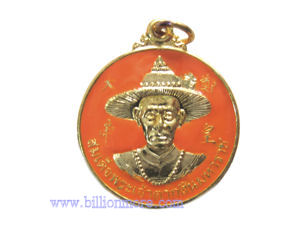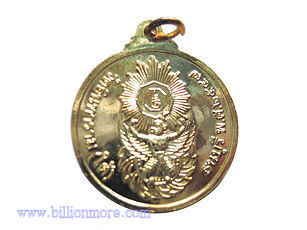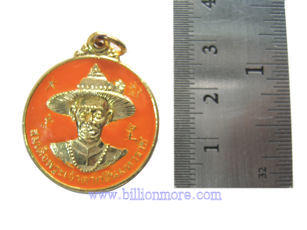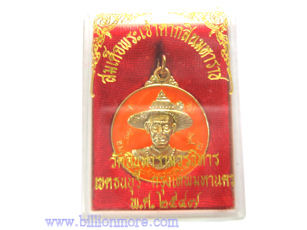|
|
PBUPM144 : Phra Chao Taksin Medal (King) (Wat IndraRam,Thai amulet)  with Katha: with Katha: KingTaksin_Master | | | |  |  |  |  | |
| 100% AUTHENTIC GUARANTEE FROM TEMPLE.
Name : Phra Chao Taksin Medal
From : Wat IndraRam, Bangkok
Purpose : Require donation of money for developing the temple.
Materials : holy metal
Size : 2.7 cm x 2.7 cm
History of Phra Chao Taksin
He was born in Ayutthaya and given the name Sin. His father Hai-Hong was of Teochew Chinese heritage, and his mother Lady Nok-lang was Thai. When aged 7 he started his education in a Buddhist monastery. After 7 years of education he was sent by his father to serve as a royal page. According to legend, when he and his friend Tong-Duang were Buddhist novices they met a Chinese fortune-teller who told them that they both had lucky lines in the palms of their hands and would both become kings. Neither took it seriously, but Tong-Duang was later the successor of King Taksin, Rama I.
Sin was first deputy governor and later governor of the Tak Province, which gained him his name Tak-Sin, even though his official noble title was Phraya Tak. When he was promoted to be governor of Kamphaeng Phet Province, he had to return to Ayutthaya. The Burmese attacked at that time and besieged the Thai capital. Taksin took a leading part in the city's defense. Shortly before Ayutthaya fell in 1767, Taksin cut his way out of the city at the head of a small army. This action was never adequately explained as the Royal compound and Ayutthaya proper was located on an island; how Taksin and his followers fought their way out of the Burmese encirclement remains a mystery
After the destruction of Ayutthaya and the death of the Thai king, the country was split into six parts, with Taksin controlling the east coast. Together with Tong-Duang, now General Chao Phraya Chakri, he managed to drive back the Burmese, defeat his rivals and reunify the country. On December 28, 1767, he was crowned king of Siam in the new capital at Thonburi. Two years later, King Taksin launched a war against the Nguyen Lords over their control of Cambodia. After some initial defeats, the joint Siamese-Cambodian army defeated the Nguyen army in 1771 and 1772. These defeats helped provoke in internal rebellion (the Tay Son rebellion) which would soon sweep the Nguyen out of power. In 1773, the Nguyen made peace with King Taksin, giving back some land they controlled in Cambodia.
King Taksin had to fight almost constantly for most of his reign to maintain the independence of his country. Thai historians indicate that the strain on him took its toll and the king started to become a religious fanatic. In 1781 Taksin showed increasing signs of madness. He believed himself to be a future Buddha, and he flogged monks who refused to worship him as such. Several historians have suggested that this tale may have been created as an excuse for his overthrow. However, the letters of a French priest who was in Thonburi at the time support the accounts of the monarch's peculiar behavior.
With the Burmese threat still remaining, a strong ruler was needed on the throne. King Taksin was declared insane and a coup d'état removed him from the throne. Although he requested to be allowed to join the monkhood, the deposed king was executed shortly after the coup on April 7, 1782. He was sealed in a velvet sack and was beaten to death with a scented sandalwood club, in accordance with the ancient tradition that no royal blood should touch the ground. His execution was viewed as necessary in order to prevent the former king's becoming the center of a possible revolt against his successor.
When the coup occurred, General Chao Phraya Chakri was away fighting in Cambodia, but he quickly returned to the Thai capital. When he arrived in Thonburi, the rebels surrendered and offered Chakri the throne as King Rama I. Another view of the events is that General Chakri actually wanted to be King and had accused King Taksin of being Chinese. However, this overlooks the fact that Chao Phraya Chakri was himself of partly Chinese origin. However, prior to returning to Thonburi, Chao Phraya Chakri had Taksin's son summoned to Cambodia and executed.
In 1981 the Thai cabinet passed a resolution to bestow on King Taksin the honorary title of the Great. The date of his coronation, December 28, is the official day of homage to King Taksin, but is not a public holiday.
Another story claims that King Taksin was not executed and actually did live out the remainder of his life as a Buddhist monk. Nevertheless, the monarch remains a favorite of Chinese-Thais and is referred to as the King of Thonburi. Taksin's equestrian statue stands in the middle of Wongwien Yai (the Big Traffic Circle) in Thonburi and is a well known Bangkok landmark.
This amulet made in 2004. People believe that this amulet can bring lucky and happiness.
|
Amulets by Wat IndraRam,Thai amulet
Total 0 Record : 1 Page :
1
Total 0 Record : 1 Page :
1
|
|

